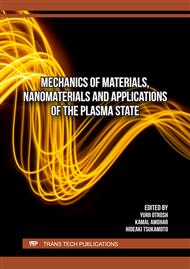[1]
S. Aicher, Bemessung biegebeanspruchter Sandwichbalken mit dem modifizierten γ-Verfahren In: Bautechnik, 03 (1987) 79-86.
Google Scholar
[2]
H. Blass, P. Fellmoser, Design of solid wood panels with cross layers. Proceedings of the 8th World Conference on Timber Engineering (Lahti, Finland), (2004) 1001-1006.
Google Scholar
[3]
H.J. Blass, R. Görlacher, Rolling shear in structural bonded timber elements. Proc. Int. Conf. on Wood and Wood fiber Composites. Stuttgart, Germany, (2000) 327-337.
Google Scholar
[4]
HJ. Blaß, M. Flaig, Shear strength and shear stiffness of CLT-beams loaded in plane. In Proceedings. CIB-W18 Meeting 46, Vancouver, Canada, (2013).
Google Scholar
[5]
T. Bogensperger, T. Moosbrugger and G. Schickhofer, "New Test Configuration for CLT-Wall-Elements under Shear Load." CIB W-18, Bled, Slovenia, (2007).
Google Scholar
[6]
T. Bogensperger, M. Augustin, G. Schickhofer, Properties of CLT-Panels Exposed to Compression Perpendicular to their Plane, CIB-W18, 44-12-1, Alghero, (2011).
Google Scholar
[7]
M. Flaig, H.J. Blaß, Shear Strength and Shear Stiffness of CLT-beams Loaded in Plane. CIB W-18, Bath, Vancouver, Canada, (2013).
Google Scholar
[8]
M. Flaig, Design of CLT beams with large finger joints at different angles. 2nd INTER Meeting, Sibenik, Croatia, (2015).
Google Scholar
[9]
H. Kreuzinger, M. Sieder, Einfaches Prüfverfahren zur Bewertung der Schubfestigkeit von Kreuzlagenholz / Brettsperrholz (in German). Bautechnik, 90(5) (2013) 314–316.
DOI: 10.1002/bate.201300024
Google Scholar
[10]
T. Moosbrugger, F. Neumüller, A. Neumüller, Schwinden und Quellen von orthogonal verklebten Holzprodukten – Teil 1: Globales Schwindverhalten von Blockbohlen und Brettsperrhölzern. In: Holztechnologie, 58 (2017) 5, IHD, Dresden.
Google Scholar
[11]
K. Möhler, Stress perpendicular to grain», CIB-W18 / 11-6-2 , Proceedings of the international council for research and innovation in building and construction, Working commission W18 – timber structures, Meeting 11, Vienna, Austria, (1979).
Google Scholar
[12]
K. Möhler, Grundlagen der Holz- Hochbaukonstructionen, in Holzbau-Atlas, Institut für intern. Architekturdokumentation, München (1980).
Google Scholar
[13]
L.A. Peterson, Zum Tragverhalten nachgiebig verbundener Biegeträger aus Holz, Berichte des Instituts für Bauphysik der Leibniz Universität Hannover Herausgeber: Univ.-Prof. Dr.-Ing. Nabil A. Fouad; Leibniz Universität Hannover - Institut für Bauphysik Heft 1 (2008).
DOI: 10.17285/0869-7035.0078
Google Scholar
[14]
R.Pischl, Die praktische Berechnung zusammengesetzter hölzerner Biegeträger mit Hilfstafeln zur Berechnung der Abminderungsfaktoren. Der Bauingenieur, 44 (1969) 181-185.
Google Scholar
[15]
R. Pischl, Die direkte Bemessung der Verbindungsmittel bei zusammengesetzten Biegeträgern im Holzbau unter Voraussetzung von DIN 1052, Absatz 5. Der Bauingenieur, 48 (1973) 293-296+470.
Google Scholar
[16]
W. Schelling, Genauere Berechnung nachgiebig verbundener Holzbiegeträger mit dem γ-Verfahren In: Festschrift E. Csiesielski. WernerVerlag (1998) 10.
Google Scholar
[17]
A. Scholz, Ein Beitrag zur berechnung von Flächentragwerken aus Holz, Dissertation, TU München, (2003).
Google Scholar
[18]
G. Schickhofer, Determination of shear strength values for GLT using visual and machine graded spruce laminations, Venice, Italy, CIB, W18 (34):12-6, (2001).
Google Scholar
[19]
G. Schickhofer, Cross Laminated Timber (CLT) in Europe – from Conception to Implementation, presentation, University of British Columbia, Department of Wood Science, Vancouver, Canada (2010).
Google Scholar
[20]
EN 1995-1-1:2008: Eurocode 5: Design of timber structures – Part 1-1: General – Common rules and rules for buildings, European Committee for Standardization CEN, Bruxelles, Belgium, (2008).
DOI: 10.3403/03174906
Google Scholar
[21]
A.M. Bidakov, Metodolohiia rozrakhunku panelei z poperechnoi kleienoi derevyny ta yikh vuzliv. Dis. dokt.tekhn. nauk. Kharkiv, (2020) 349.
Google Scholar
[22]
P. Szeptynski, Closed-form analytical solution to the problem of bending of a multilayer composite beam – Derivation and verification, Composite Structures. 291 (2022) 115611.
DOI: 10.1016/j.compstruct.2022.115611
Google Scholar
[23]
A.R. Rzhanitsyin, Sostavnyie sterzhni i plastinki. M., (1986) 315.
Google Scholar
[24]
S. Timoshenko, Woinowsky-Krieger, Theory of Plates and Shells. New York Toronto London, (1959) 635.
Google Scholar
[25]
T. Azizov, Determination of Bending and Torque moments in Orthotropic Plate as in a Crossbeam System, Sciences of Europe, 1 87(2022) 61-63.
Google Scholar
[26]
T. Azizov, Improvement of the Displacement Method for the Calculation of Reinforced Concrete Rod Systems// Sciences of Europe, 96 (2022) 33-37.
Google Scholar
[27]
T. Azizov, D. Kochkarev, Limits of Using the Theory of Plates in the Calculation of Reinforced Concrete Slabs, Sciences of Europe, 111(2023) 28-32.
Google Scholar
[28]
T.N. Azizov, A.V. Kovrov, R. Pereiras, Do pytannia skincheno-elementnoho modeliuvannia pry rozrakhunku zalizobetonnykh plyt, Resursoekonomni materialy, konstruktsii, budivli ta sporudy.– Rivne: Nats. un-t vodnoho hospodarstva ta pryrodokorystuvannia, 45 (2024) 85-95.
Google Scholar
[29]
DBN V.2.6-161:2017. Dereviani konstruktsii. Osnovni polozhennia. Kyiv, (2017) 111.
Google Scholar
[30]
EN 338:2009-10, "Structural timber – Strength classes" European Committee for Standartisation, Brussels (2009).
Google Scholar


